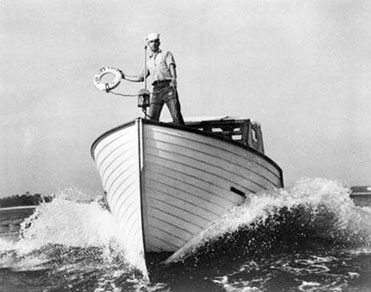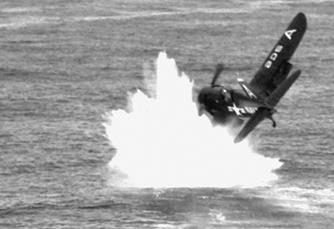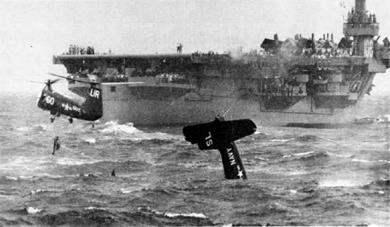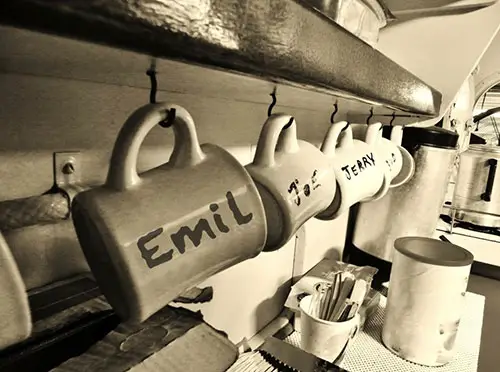US Navy Crash/Rescue Boats - Their Purpose and Function
IT TAKES BALLS TO RUN A CRASH BOAT
"On this particular day I'm aboard Roosevelt Roads Naval Air Station's solitary crash/rescue boat, putting together a story about the vessel's purpose and function. The skipper, Emil Novak, a weathered chief bosun mate, is instructing two aspiring bosun strikers through a faux rescue exercise, using various floatation and retrieval devices (the chief even carried a uniformed mannequin aboard!). We're adrift, with the engine idling. In the middle of the roadway, there's a light cruiser anchored. At the moment I'm trying to get a good angle shot of the life-saving maneuvers, using my trusty 4x5 Speed Graphic camera.

"Navy and Coast Guard crash/rescue boats come in a variety of sizes and designs. This 1944 wooden model measures 32 feet. Later variants featured all-metal hulls, the longest stretching to 104 feet."
"From out of nowhere comes this hell-bent Marine pilot behind the controls of an A-4M Skyhawk 11. He approaches from ocean-side, then goes inland and makes a wide half-circle and re-enters the roadway, flying directly over the top of the cruiser. I'm guessing he's doing around 200mph-plus. He then cuts sharply to port and drops down to about 50 feet, the port wingtip pointing straight down at the water. He continues turning left in a steep bank as he approaches the cruiser on a parallel course. For some reason (not paying closer attention?) the plane drops even lower -- and lower still. The wing tip touches the water just as the chief cries out: "GEE-ZUS KEE-RYST!”
This series of photos loosely duplicates the Roosevelt Roads mishap

Wingtips and water make for bad bedfellows, as the pilot of this F4U Corsair discovers after getting a landing wave-off from the carrier USS Boxer. But all ends well when the Boxer's rescue chopper arrives in the nick of time.

"The chief -- in total disbelief, as we all are -- races inside the cabin and gets underway, full throttle. In the distance we can see a rush of activity aboard the cruiser, and then what appears to be the captain's motorized gig being lowered. The chief enters the debris field, slows down to a crawl, and orders the two seamen to stand by on either side of the bow with a pair of 15-foot boat hooks, and to keep a sharp lookout.
"We make a couple passes up and down. I climb atop the wheelhouse roof, which vantage point greatly increases my field of view, and start shooting. Between exposures, I keep looking for signs of life despite the overwhelming survival odds against that happening. Every now and then the crash boat hull makes contact with sinking fragments of the plane. There's a lot of back-and-forth shouting on bullhorns once the gig arrives. After maybe 10 minutes the commotion subsides, and that's when I notice one of the seamen pull something on board using one of the boat hooks.
"I climb down and go forward. The chief is busy amidship examining what later turns out to be a badly lacerated parachute pack. Ahead, laid out on the bow deck, is an entangled khaki pants leg and a torn pair of boxer shorts. The seaman who's trawled this conglomeration from out of the briny is down on his knees, poking at something with his fingers. He suddenly gives a tug and comes up with the following: a spermatic cord, from which dangles a single gonad.
"When it suddenly dawns what's in his hand, the sailor springs to his feet and begins frantically looking around. Then -- deliverance! (I can read the relief on his face). He scoots across the deck to a ledge running along the inside of the gunnel, upon which sits a container.
'Plop' goes the gonad...
"As I mentioned at the outset, the chief is a well-seasoned salt -- half bosun, the other half coxswain. In a later conversation I have with him, I learn he's driven infantry landing craft at Peleliu, Okinawa, Guam, and is slightly wounded coming ashore at Luzon, in the Philippines. He's also been through a number of sea battles, including kamikaze attacks. He has many mementos and souvenirs relating to the old days, but none does he hold closer to his heart than an over-sized ceramic coffee mug with its array of 18-karat gold leaf lettering spelling out all the battles he'd been through. The mug goes wherever its owner does; it might even be said they are joined -- not at the hips -- but at the lips. I repeat -- at the lips.
"When the chief discovers what lies nestled at the bottom of his beloved cup, he absolutely freezes. His unbroken gaze lasts all of 15 seconds. Then, with an animal roar, he smashes the cup on the deck and turns to face his tormentor. The seaman in turn spins around and runs for the wheelhouse. Had the latter reacted a few seconds later than he did, he'd never have made it inside and latched the door in time. It came this close to being two KIA.
"The gig motors over and half-a-dozen sailors -- alarmed by all the shouting and cursing -- climb aboard. They coax the kid to come out and then form a protective ring around him. And that's how we went back to the dock -- with CPO Emil Novak outnumbered and blaspheming behind the wheel, and the gig following in our wake.
"The Marine pilot? It turns out his brother is the engineering officer aboard the cruiser. They'd talked ship to shore, and the engineer asked his brother to pay a visit the next time he was airborne and do some aerial gymnastics to impress the crew. Impress them he did....far above and beyond the call of duty.
"I write a first-person account of the crash -- its big news on base -- but it isn't the story I want to tell. The tale I really wish to relate, you've just read. "
EPILOGUE

Tony Welch
JO2, USN
he author, a Navy journalist -- or 'word merchant' as his shipmates preferred to call him -- was the editor of the base newspaper at Roosevelt Roads Naval Air Station in the late fifties. Located forty miles from San Juan, Puerto Rico, Rosey Roads (as everyone called it) was a left-over piece of Navy real estate dating back to WW11. In 1941 it was established as a possible operating base for the Queen's Navy in the event England should fall to the invading Germans. Then resurrected again as the gunnery exercise operational base for the Atlantic fleet. But it didn't stop there: Roosevelt Roads over time expanded to become the largest naval facility in terms of acreage, sporting over 1,300 buildings and home to 7,000 personnel and their dependents. Then Rosey Roads once again closed its doors in 2004. To date, numerous attempts to lure tourism enterprises to the site have failed -- leaving behind what might be termed the Navy's costliest ghost town. Plus a tale as yet untold...until now.
Published with Permission on GG Archives, September 2013. © Tony Welch
